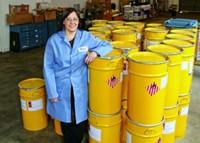Advertisement
Grab your lab coat. Let's get started
Welcome!
Welcome!
Create an account below to get 6 C&EN articles per month, receive newsletters and more - all free.
It seems this is your first time logging in online. Please enter the following information to continue.
As an ACS member you automatically get access to this site. All we need is few more details to create your reading experience.
Not you? Sign in with a different account.
Not you? Sign in with a different account.
ERROR 1
ERROR 1
ERROR 2
ERROR 2
ERROR 2
ERROR 2
ERROR 2
Password and Confirm password must match.
If you have an ACS member number, please enter it here so we can link this account to your membership. (optional)
ERROR 2
ACS values your privacy. By submitting your information, you are gaining access to C&EN and subscribing to our weekly newsletter. We use the information you provide to make your reading experience better, and we will never sell your data to third party members.
Business
An Entrepreneurial Enigma
by Philip J. Wyatt
August 19, 2013
| A version of this story appeared in
Volume 91, Issue 33
This guest editorial is by Philip J. Wyatt, founder and chief executive officer of Wyatt Technology Corp., a family-owned developer of light-scattering instrumentation and software based in Santa Barbara, Calif.
Job creation in the U.S. depends on expanding the industrial manufacturing base. Each job created in the chain of manufacturing activity generates, on average, 2.5 jobs in unrelated endeavors. Innovation and entrepreneurship are hailed as the best path to job growth. But this path is fraught with problems, often leading to destruction of the entrepreneur’s creative spark, ruined lives, and a decrease in employment.
Start-ups require capital, which may come from the entrepreneurs themselves, their associates, or private and venture capital investors. These investments are often made with preconditions of an “exit strategy” to enable investors to recoup their investments and, if possible, make a hefty profit. Other than failure, the fate of most start-ups is acquisition or to “go public.” Both outcomes usually repay or enrich the early investors and entrepreneurial founders.
It is never a planned objective of an acquisition to increase employment at the expense of profitability. Acquirers have many motives. They may want to replace existing products with perceived better ones or to eliminate competition. Under any of these scenarios, net increases in employment—new jobs—are rare.
Acquisitions have other consequences: The internal creativity of the acquired company diminishes and, in many cases, may be extinguished. The careers of young, recently hired, and often brilliant technologists in the acquired company are interrupted. Some employees of the acquired company become redundant immediately and lose their jobs. Others must relocate, and if they would rather not move, they join the ranks of the unemployed. For people in the middle or late stages of their professional lives, a termination could spell the end of their careers.
Often the acquirer is a public company that must answer to shareholders. Meanwhile, shareholders always expect greater profits and a higher stock value after an acquisition. Brilliant entrepreneurs rarely remain with such an acquirer, and with their departure go the jobs they might have created but now never will.
New ventures may opt for an initial public offering (IPO) of stock to meet capital needs that can no longer be provided privately. Once a company becomes publicly traded, however, its focus shifts to satisfying shareholders’ needs. And when early investors and key founders cash out some equity, share prices drop. For new public companies, it is a tricky balancing act to meet shareholder expectations while advancing innovation. When firms fail after an IPO, as many do, public investors lose money and the creative talent of the failed company must seek new employment.
The case of NanoInk is the most recent of many entrepreneurial failures. I can cite many more examples of new ventures dying after they are acquired or go public. A 2012 study by the American Institute of Physics concludes that a major reason for failure is that the companies’ goals “are not aligned with those of the funders who pay the bills.”
What the U.S. needs is entrepreneurially driven, privately owned manufacturing companies that aim for independent growth for 100 years! Firms thus formed must expand their founding-technology-based products continually with developments by new innovators guided by the older founders among them.
Such companies are exemplified by two privately owned, chemistry-driven firms. One is W. L. Gore, the 55-year-old, employee-owned manufacturer of advanced technology products for the electronics, industrial, fabrics, and medical markets.
Another is S. C. Johnson & Son, the thriving, 127-year-old, family-owned global household products enterprise. The firm maintains extensive research facilities and supports programs to train chemistry and chemical engineering students and expose them to the world of innovative research.
Entrepreneurs will be well served by studying these two companies, considering starting with their own money, and seeking outside funding only with no strings attached.
Views expressed on this page are those of the author and not necessarily those of ACS.




Join the conversation
Contact the reporter
Submit a Letter to the Editor for publication
Engage with us on Twitter